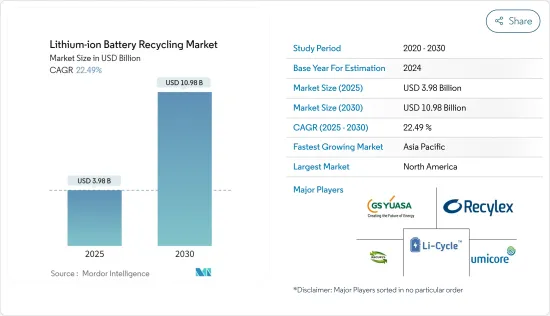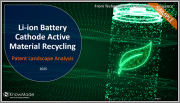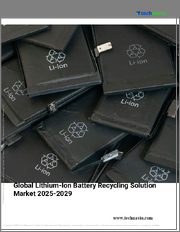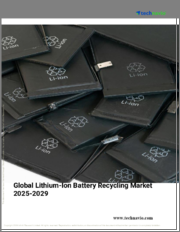
|
시장보고서
상품코드
1687473
리튬이온 배터리 재활용 : 시장 점유율 분석, 산업 동향 및 통계, 성장 예측(2025-2030년)Lithium-ion Battery Recycling - Market Share Analysis, Industry Trends & Statistics, Growth Forecasts (2025 - 2030) |
||||||
리튬이온 배터리 재활용 시장 규모는 2025년에 39억 8,000만 달러로 추정되며, 예측 기간(2025-2030년) 동안 22.49%의 CAGR로 2030년에는 109억 8,000만 달러에 달할 것으로 예상됩니다.

다양한 종류의 배터리 재활용 기술 중에서도 리튬이온 배터리(LIB) 재활용 시장은 예측 기간 후반에 전 세계 배터리 재활용 시장을 장악할 것으로 예상됩니다. 또한, 리튬이온 배터리의 가격 하락과 전기자동차의 보급으로 인한 리튬이온 배터리 사용량 증가, 배터리 폐기물 처리에 대한 우려의 증가와 정부의 엄격한 정책은 예측 기간 동안 리튬이온 배터리 재활용 시장을 견인할 것으로 보입니다. 그러나 리튬이온 배터리를 제조하기 위한 원자재는 저렴한 비용으로 얻을 수 있는 반면, 리튬이온 배터리를 재활용하는 데는 높은 비용이 소요됩니다. 높은 비용과 더불어 견고한 공급망의 부재, 배터리 재활용과 관련된 낮은 수율은 예측 기간 동안 배터리 재활용 시장의 성장을 저해할 가능성이 높습니다.
주요 하이라이트
- 재생에너지 발전을 촉진하는 정책적 차원의 노력과 전기자동차의 대량 도입에 따라 에너지 저장 솔루션이 필요한 전력 부문이 크게 성장하고 있습니다.
- 제조업체가 개발하는 기술적으로 진보된 배터리의 창조로 이어지는 배터리 기술 주요 기업의 개발은 획기적인 배터리 재활용 기술을 만들기 위해 투자하고 자원을 투입하는 배터리 재활용 기업에게 큰 기회를 창출할 가능성이 높습니다.
- 아시아태평양은 제조업, 재생에너지, 전기자동차 수요 증가로 인해 예측 기간 동안 리튬이온 배터리 재활용 시장을 주도할 것으로 예상됩니다.
리튬이온 배터리 재활용 시장 동향
전력 산업의 수요 증가
- 리튬이온 배터리 가격은 지난 10년 동안 급락하고 있으며, 2018 년 리튬이온 배터리 가격은 1kWh 당 176 달러였습니다. 리튬이온 배터리 가격은 지속적으로 하락하고 있으며, 2018년 가격은 2017년 대비 17.75% 하락했습니다. 리튬이온 배터리는 ESS 등 전력 분야와 관련된 다양한 응용 분야에 사용되고 있으며, 전력 분야 시장을 주도할 가능성이 높습니다.
- 비용 절감의 주요 이유는 다음 두 가지로 요약할 수 있습니다:
- 배터리 재료의 개선, 비활성 재료의 양과 재료 비용 절감, 셀 설계 및 생산 수율 개선, 생산 속도 향상을 목표로 한 지속적인 연구 개발을 통해 배터리 성능을 꾸준히 향상시킴.
- 리튬이온 배터리 제조의 규모의 경제 달성에 기여한 중국을 중심으로 한 전력산업 최종사용자 대상 생산량 증가와 제조업체 간 경쟁을 심화시킨 대규모 생산능력 증설(가격은 더욱 하락했지만, 제조업체의 수익성은 희생됨).
- 이러한 추세는 급격하고 지속적인 비용 절감을 가져와 리튬 이온이 그리드 규모, 비하인드 더 미터 스토리지, 주거용 스토리지, 마이크로그리드 등 모든 에너지 저장 및 전력 산업 시장에서 리튬 이온이 배터리 화학의 선택이 되는 데 도움이 될 것으로 예상됩니다.
- 또한, 리튬이온 배터리의 평균 가격은 계속 하락하여 2025년까지 약 100달러/kWh에 도달할 것으로 예상됩니다. 이러한 추세로 인해 예측 기간 동안 태양광, 풍력, 수력 등 재생에너지와 결합된 에너지 저장 시스템(ESS)과 같은 새롭고 흥미로운 시장에서의 리튬이온 배터리의 적용이 주거용 및 상업용 모두에서 증가할 것으로 예상됩니다.
- 따라서 가격 하락에 따라 전력 산업에서 리튬이온 배터리의 사용이 증가할 것으로 예상됩니다. 이러한 배터리의 채택을 보다 지속가능하고 환경 친화적으로 만들기 위해 이러한 배터리를 재활용할 필요성도 예측 기간 동안 가속화될 것으로 예상됩니다.
아시아태평양이 시장을 장악
- 리튬이온 배터리는 기존에는 주로 휴대폰, 노트북, PC 등 민생용 전자기기에 사용되어 왔으나, EV는 CO2, 질소산화물 등 온실가스를 배출하지 않아 환경 부하가 적다는 이유로 하이브리드 자동차나 완전 전기자동차(EV)의 전원으로 사용되도록 설계가 재검토되고 있습니다. 사용되도록 설계가 재검토되고 있습니다.
- 전기자동차 및 에너지 저장 시스템(ESS)과 같은 새롭고 흥미로운 시장의 출현은 상업용 및 주거용 애플리케이션 모두에서 LIB의 수요를 주도하고 있습니다. 또한, ESS는 풍력, 태양광, 수력 등 재생에너지와 결합하여 전력망의 안정성을 높이기 위해 기술적으로나 상업적으로 필요하며, 그 결과 LIB 분야를 주도하고 있습니다.
- 현재 중국은 전 세계 전기자동차 판매량의 약 40%를 차지하는 가장 큰 시장입니다. 중국은 국내 대기오염 수준을 낮추기 위해 노력하고 있으며, 전기자동차 판매량은 높은 성장률을 기록할 것으로 예상되며, 이는 LIB의 높은 수요로 이어지고 있습니다.
- 현재 중국은 전기자동차용 리튬이온 배터리의 최대 생산국입니다. 중국의 리튬 생산량은 2017년 6,800톤에서 2018년 8,000톤으로 증가했습니다. 배터리는 항상 환경 문제와 관련이 있기 때문에 중국 정부는 업계가 필요에 따라 재활용 시설을 설치해야 한다는 정책을 제시하고 있습니다.
- 또한, 인도 정부는 2018년 8월 전기자동차 도입과 리튬이온 배터리의 현지 생산을 장려하기 위해 하이브리드 및 전기자동차의 신속한 도입 및 제조(FAME) 인도 계획의 2단계에 5,500 crore 인도 루피의 지출을 지시했습니다. 이에 따라 아마존, 아마라 라자 배터리(Amara Raja Batteries) 등 인도의 자동차 부품 제조업체와 전력 및 에너지 솔루션 제공업체들은 인도 내 급성장하는 친환경 자동차 시장을 활용하기 위해 리튬이온 배터리의 현지 생산 계획을 세우고 있습니다.
- 또한, 이 지역 정부의 기술개발을 위한 R&D 투자는 재활용 공정에 소요되는 비용을 절감하는 데 도움이 되며, 재활용 기업이 재활용 재료를 새로운 제품 생산에 활용하도록 동기를 부여하여 시장 성장에 기여할 것입니다. 따라서 최근 동향은 예측 기간 동안 리튬이온 배터리 재활용 시장을 촉진할 것으로 예상됩니다.
리튬이온 배터리 재활용 산업 개요
리튬이온 배터리 재활용 시장은 복잡한 기술로 인해 이 산업에서 사업을 전개하는 기업이 적고, 적당히 단편화되어 있습니다. 이 시장의 주요 기업으로는 Glencore, GS Yuasa Corporation, Li-Cycle Technology, Recupyl Sas, Umicore, Metal Conversion Technologies 등이 있습니다.
기타 특전:
- 엑셀 형식의 시장 예측(ME) 시트
- 3개월 애널리스트 지원
목차
제1장 소개
- 조사 범위
- 시장 정의
- 조사 가정
제2장 주요 요약
제3장 조사 방법
제4장 시장 개요
- 소개
- 2025년까지 시장 규모 및 수요 예측
- 최근 동향과 개발
- 정부 규제와 정책
- 시장 역학
- 성장 촉진요인
- 성장 억제요인
- Porter's Five Forces 분석
- 공급 기업의 교섭력
- 소비자의 협상력
- 신규 참여업체의 위협
- 대체품의 위협 제품 및 서비스
- 경쟁 기업 간의 경쟁 관계
제5장 시장 세분화
- 산업별
- 자동차
- 해양
- 전력
- 기타
- 기술
- 습식 야금 프로세스
- 건식 야금 프로세스
- 물리적/기계적 프로세스
- 지역
- 북미
- 아시아태평양
- 유럽
- 남미
- 중동 및 아프리카
제6장 경쟁 구도
- M&A, 합작투자, 제휴, 협정
- 주요 기업의 전략
- 기업 개요
- Glencore PLC
- Green Technology Solutions, Inc.
- Li-Cycle Technology
- Recupyl Sas
- Umicore SA
- Metal Conversion Technologies LLC
- Retriev Technologies Inc.
- Raw Materials Company
- TES-AMM Pte Ltd.
- American Manganese
제7장 시장 기회와 향후 동향
ksm 25.05.12The Lithium-ion Battery Recycling Market size is estimated at USD 3.98 billion in 2025, and is expected to reach USD 10.98 billion by 2030, at a CAGR of 22.49% during the forecast period (2025-2030).

Among different types of battery recycling technology, the lithium-ion battery (LIB) recycling market is expected to dominate the global battery recycling market in the latter part of the forecast period, majorly due to the demand for lithium-ion batteries and its ability such as favorable capacity-to-weight ratio. Moreover, Rising concerns over battery waste disposal and stringent government policies clubbed with the increase in usage of lithium-ion battery due to the declining lithium-ion battery prices and growing adoption of electric vehicles, are likely to drive the lithium-ion battery recycling market during the forecast period. However, the raw materials for the manufacturing of lithium-ion batteries are available at a low cost, whereas a high cost is incurred in recycling. The high cost, along with the lack of a strong supply chain and low yield related to battery recycling, is likely to restrain the growth of the battery recycling market during the forecast period.
Key Highlights
- The power sector witnessing significant growth owing to requirement for energy storage solutions in the wake of policy-level initiatives to promote renewable power generation and massive deployment of electric vehicles.
- Advancements in battery technologies leading to the creation of technologically advanced batteries being developed by manufacturers are likely to create a massive opportunity for the battery recycling companies to invest and redirect their resources to make a breakthrough battery recycling technology.
- Asia-Pacific is expected to lead the lithium-ion battery recycling market, during the forecast period, due to the growth of the manufacturing sector, renewables power and the EV demand.
Lithium-Ion Battery Recycling Market Trends
Increasing Demand In Power Industry
- The price of lithium-ion batteries has fallen steeply over the past 10 years. In 2018, the lithium-ion battery price was USD 176 per kWh. Lithium-ion battery prices are falling continuously, and the price decreased by 17.75% in 2018 compared to the price in 2017. The lithium-ion battery used in various application related to power sector such as ESS and other, which in turn likely to drive the market in power sector.
- The two principal reasons for the drastic cost decline are:
- The steady improvement of battery performance achieved through sustained R&D, aimed at improving battery materials, reducing the amount of non-active materials and the cost of materials, improving cell design and production yield, and increasing production speed.
- Increase in production volume for end user in power industry, particularly in China, which helped in achieving the economies of scale in lithium-ion battery manufacturing, and the large capacity additions, which increased the competition among manufacturers (further declining the prices, but at the expense of the profitability of the manufacturers).
- These trends result in sharp and sustained cost reduction which is expected to help cement lithium-ion as the battery chemistry of choice in all energy storage, power industry markets, including grid-scale, behind-the-meter storage, residential storage, and micro-grids.
- Furthermore, the decline in average lithium-ion battery prices is expected to continue and reach approximately USD 100/kWh by 2025, in turn, making it much more cost-competitive than other battery types. The trend is expected to result in an increased application of lithium-ion batteries in new and exciting markets, such as energy storage systems (ESS), paired with renewables, like solar, wind, or hydro, for both residential and commercial applications, during the forecast period.
- Hence, with declining prices, the use of lithium-ion batteries is expected to rise in power industry. The need for recycling these batteries is also expected to gain pace during the forecast period, in order to make the adoption of such batteries more sustainable and eco-friendlier.
Asia-Pacific to Dominate the Market
- Lithium-ion batteries have traditionally been used mainly in consumer electronic devices, such as mobile phones, notebook, and PCs, but are now increasingly being redesigned for use as the power source of choice in hybrid and the complete electric vehicle (EV) range, owing to factors, such as low environmental impact, as EV does not emit any CO2, nitrogen oxides, or any other greenhouse gases.
- The emergence of the new and exciting markets, such as electric vehicle and energy storage systems (ESS), for both the commercial and residential applications, is driving the demand for LIB. Moreover, ESS, coupled with renewables, such as wind, solar, or hydro, is technically and commercially necessary for increasing grid stability, consequently, driving the LIB segment.
- Currently, China is the largest market for electric vehicles, as the country accounts for around 40% of the global sale. China is making efforts to reduce the air pollution level in the country, and it is expected to register a high growth rate in the electric vehicle sales, consequently, leading to the high demand for LIB.
- Currently, China is the largest manufacturer of lithium-ion battery majorly for electric vehicles. In China, lithium production in the country, increasing from 6,800 metric tons in 2017 to 8,000 metric tons in 2018. As batteries are always related to environmental concerns, the government of china presents a policy for recycling facilities that the industry must set up as required.
- Furthermore, in August 2018, the Government of India directed an outlay of INR 5,500 crore for the second phase of the Faster Adoption and Manufacturing of Hybrid and Electric Vehicles (FAME) India Scheme, for encouraging the adoption of EVs and local manufacturing of lithium-ion batteries. Thus, several automobile component manufacturers and power and energy solution providers in India, such as Amazon and Amara Raja Batteries, have put forth plans for manufacturing lithium-ion batteries locally, to leverage the booming green vehicles market in the country.
- Additionally, the R&D investment by the government in the region on developing technologies can help decrease the cost incurred for the recycling process, which can motivate the recycling companies to take up recycled material for manufacturing a new product, and thereby, helping the growth of the market. Hence the recent trends are expected to propel the lithium-ion battery recycling marketduring the forecast period.
Lithium-Ion Battery Recycling Industry Overview
The lithium-ion battery recycling market is moderately fragmented due to few companies operating in the industry because of the complex technology. The key players in this market include Glencore, GS Yuasa Corporation, Li-Cycle Technology, Recupyl Sas,Umicore, Metal Conversion Technologies, and others.
Additional Benefits:
- The market estimate (ME) sheet in Excel format
- 3 months of analyst support
TABLE OF CONTENTS
1 INTRODUCTION
- 1.1 Scope of the Study
- 1.2 Market Definition
- 1.3 Study Assumptions
2 EXECUTIVE SUMMARY
3 RESEARCH METHODOLOGY
4 MARKET OVERVIEW
- 4.1 Introduction
- 4.2 Market Size and Demand Forecast, in USD billion, until 2025
- 4.3 Recent Trends and Developments
- 4.4 Government Policies & Regulations
- 4.5 Market Dynamics
- 4.5.1 Drivers
- 4.5.2 Restraints
- 4.6 Porter's Five Forces Analysis
- 4.6.1 Bargaining Power of Suppliers
- 4.6.2 Bargaining Power of Consumers
- 4.6.3 Threat of New Entrants
- 4.6.4 Threat of Substitutes Products and Services
- 4.6.5 Intensity of Competitive Rivalry
5 MARKET SEGMENTATION
- 5.1 Industry
- 5.1.1 Automotive
- 5.1.2 Marine
- 5.1.3 Power
- 5.1.4 Others
- 5.2 Technology
- 5.2.1 Hydrometallurgical Process
- 5.2.2 Pyrometallurgy Process
- 5.2.3 Physical/Mechanical Process
- 5.3 Geography
- 5.3.1 North America
- 5.3.2 Asia-Pacific
- 5.3.3 Europe
- 5.3.4 South America
- 5.3.5 Middle-East and Africa
6 COMPETITIVE LANDSCAPE
- 6.1 Mergers and Acquisitions, Joint Ventures, Collaborations, and Agreements
- 6.2 Strategies Adopted by Leading Players
- 6.3 Company Profiles
- 6.3.1 Glencore PLC
- 6.3.2 Green Technology Solutions, Inc.
- 6.3.3 Li-Cycle Technology
- 6.3.4 Recupyl Sas
- 6.3.5 Umicore SA
- 6.3.6 Metal Conversion Technologies LLC
- 6.3.7 Retriev Technologies Inc.
- 6.3.8 Raw Materials Company
- 6.3.9 TES-AMM Pte Ltd.
- 6.3.10 American Manganese



















